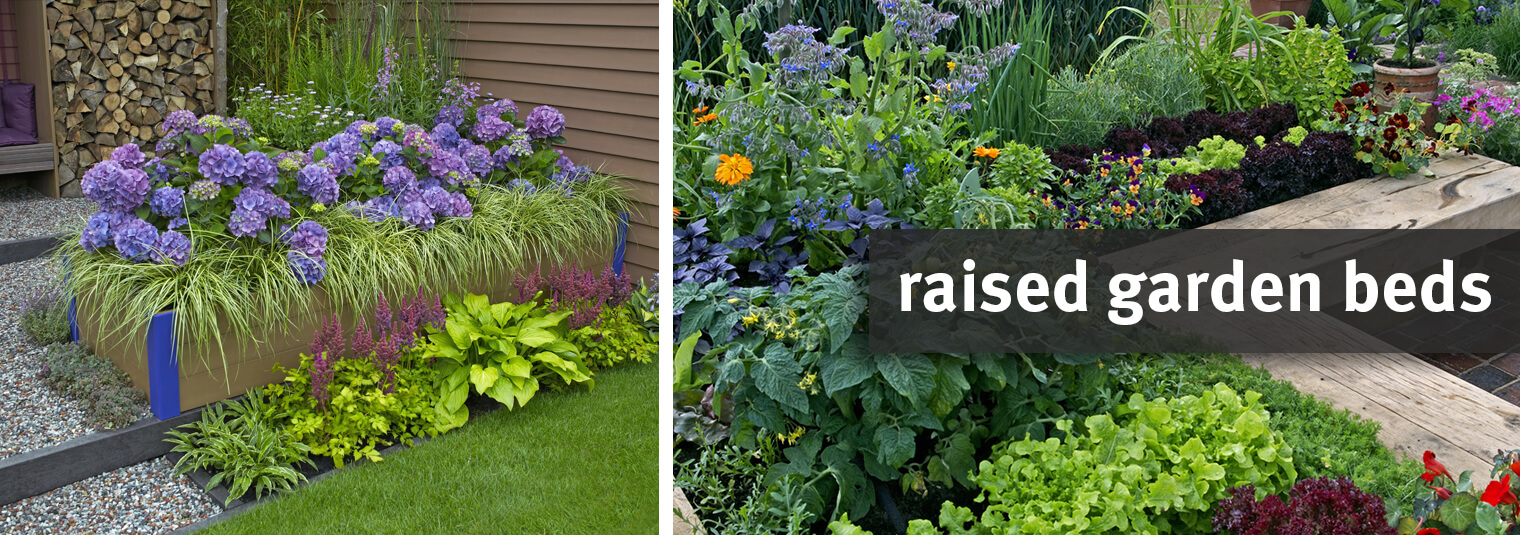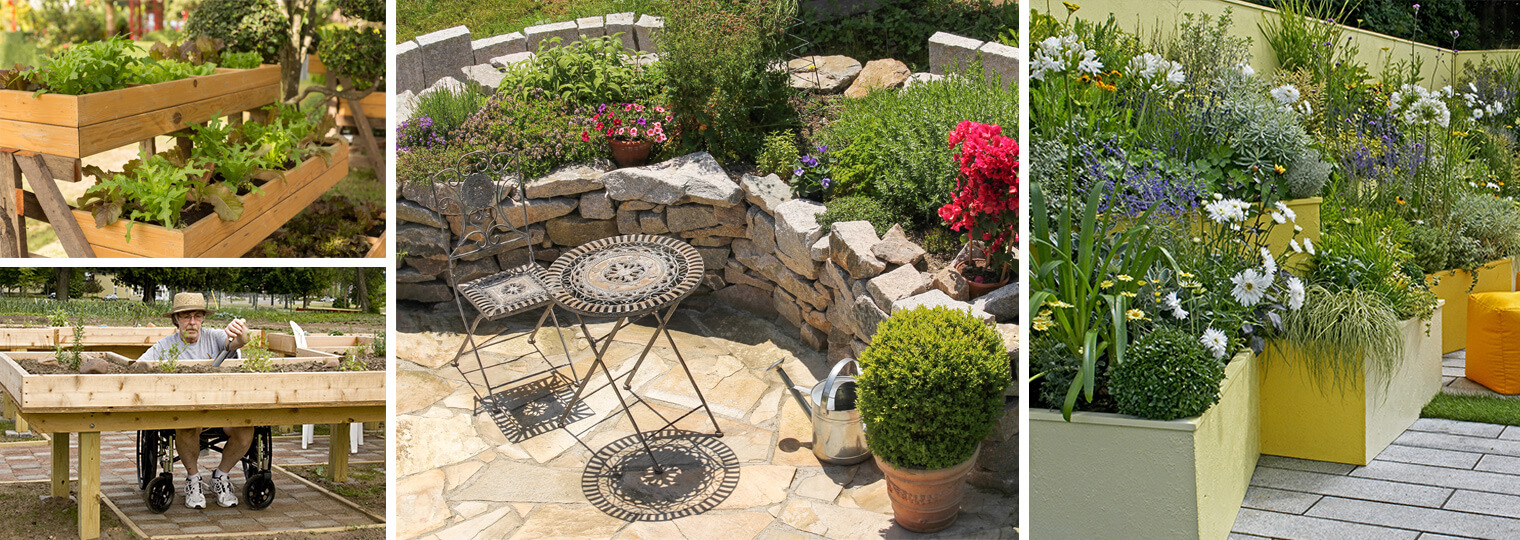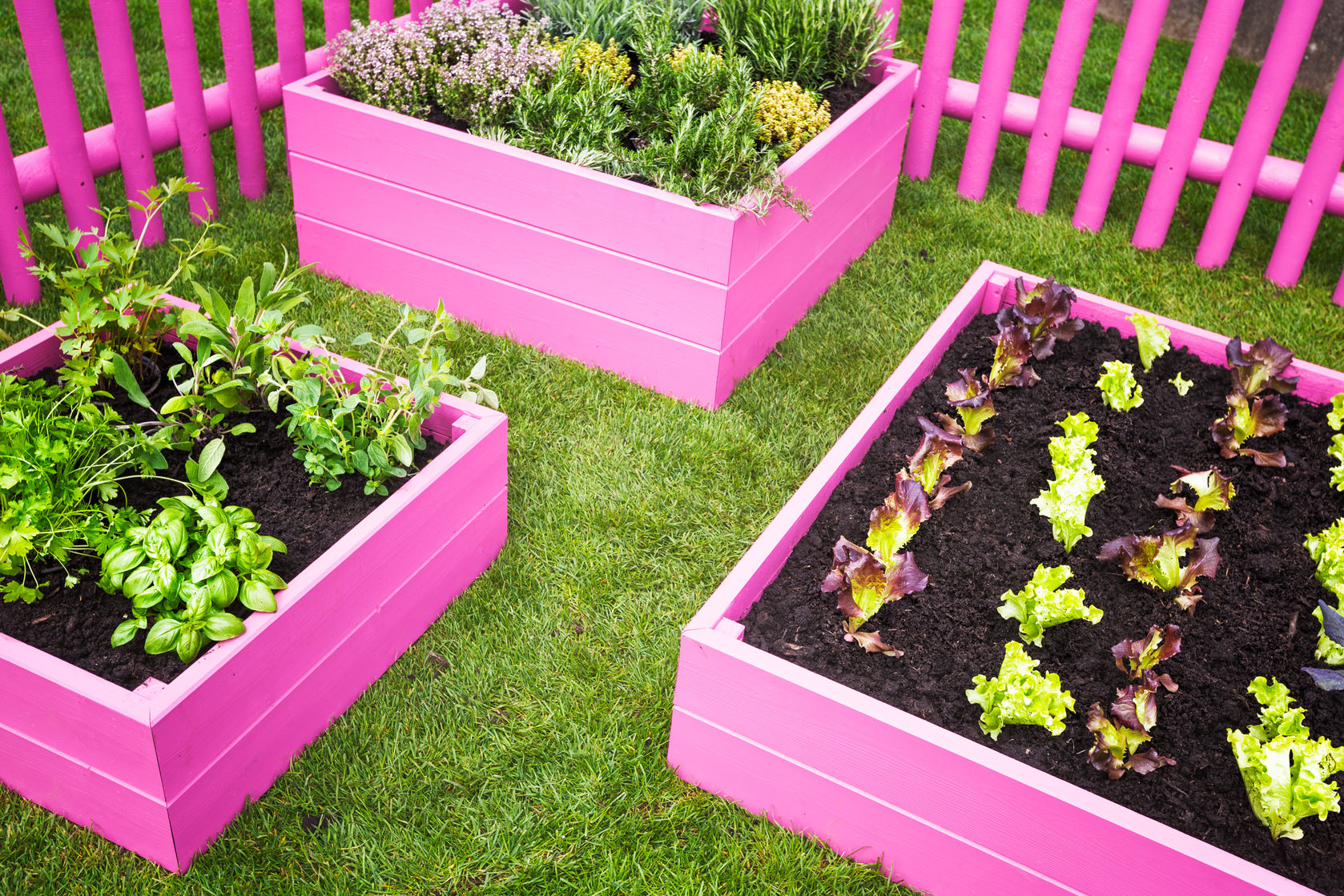 Back to the Be Inspired Blog
Back to the Be Inspired Blog

Raised Beds in the Garden: Why They Matter and How to Build Them
You may not have considered raised beds for your garden before, but they’re a fantastic way to plant vegetables and flowers in your yard. Creating a garden in raised beds is ideal for a variety of reasons:
- They can be used for most types of plants, from seasonal edibles and annuals to perennials and small shrubs
- They’re a good option if the ground is difficult to dig
- They can be beneficial if your back or knees are tender
- They are aesthetically pleasing for your yard
- They help control soil conditions, provide better drainage, help you manage soil depth and limit soil compaction
- They serve as a pest barrier
- They get warm faster in the spring
Whatever the reason, DIY raised beds are easy to build and even easier to use! Keep reading to learn about the different types of raised beds, how to create them and how to plant in them.
The Different Types of Raised Beds
Raised beds can be made to fit any location and can even be built with supplies you may have laying around. You can also make DIY raised garden beds from rock, straw bales, old pallets cut down and lined with burlap, and more. We recommend building raised beds with cedar or redwood since they do not rot or break down like other woods. Or, if you’d rather, pre-made boxes are available for purchase and come in a number of sizes for your convenience. Some are wood and others are made from recycled materials. The minimum height of a raised garden should be one foot. If you are using wood, you can use more than one plank to build taller beds or to create multiple levels for planting different types of plants. When designing your elevated garden, you can be as creative as you’d like and even incorporate a bench to sit on for easy garden maintenance and enjoyment. Pick a location that will allow for six to eight hours of daily sun - more sun in the winter and less sun in the summer. Consider the placement in terms of having easy access, too. If you will only be able to reach one side of your raised beds, a depth of no more than two feet is ideal.
How to Build Raised Beds Are you looking to build your own raised beds? Check out this step-by-step guide to build a 4-by-8-foot bed.
Materials Needed:
- Four 16-inch-long 4-by-4s, to act as corner posts
- Two 4-foot-long 2-by-12s for bed ends
- Two 8-foot-long 2-by-12s for bed sides
- Twenty-four 3 1/2-inch #14 galvanized or stainless steel screws
- Twenty-four 1/2-inch #8 galvanized or stainless steel screws (optional)
- Six 12-inch-long pieces of 1/2-inch PVC pipes (optional)
- Three 10-foot-long pieces of 3/8-gauge rebar (optional)
- Three 3-by-5-foot rolls of 1/4-inch-mesh hardware cloth, to deter burrowing animals (optional)
- Twelve 1-inch galvanized tube straps (optional)
- One roll bird netting or floating row cover (optional)
- Sixteen cubic feet of planting soil
- Sixteen cubic feet of compost
- Drip-watering system (optional)
Tools:
- Drill
- 5/32-inch drill bit
- Pencil
- Ruler
- Shovel or trowel
- Level (optional)
- Gloves
- Staple gun
- Wire cutters
- Four adjustable woodworking bar clamps: Two 12 inches and two 6 feet (optional)

Building the Frame:
To start, you’ll build the frame upside down. While working on a flat surface, set a 4-foot 2-by-12 board on its narrow side edge on the ground; at one end of the board, place a 16-inch 4-by-4 corner post upright and flush with the end of the board. Use two adjustable woodworking clamps or a friend to keep both pieces of wood flush on the sides and bottom. Before securing the post to the 4-foot board, help prevent the wood from splitting by predrilling three evenly spaced holes in the board with the 5/32-inch drill bit. Then secure the board to the post with three three 1/2-inch screws. Repeat the above technique to attach a corner post to the other end of the 4-foot board. Then grab the remaining 4-foot board and attach a corner post to each end. You now have the two 4-foot ends of your raised bed and are ready to attach the bed’s longer sides: Position the first of your 8-foot 2-by-12 side boards between your two 4-foot bed ends. Make sure the 8-foot board is flush with each corner post (hold them steady with the woodworking clamps or grab your friend again), then predrill each board end with three holes and secure it to a post with three 3 1/2-inch screws. Repeat to attach the remaining 8-foot side board to the awaiting corner posts.
Putting the Raised Bed in Place: Once you’ve decided on a bed location, dig a 5- to 6-inch-deep hole for each of the corner posts. Then sink each post into the ground. Make sure the bed is level on all sides (using a level if you have one); this will ensure that irrigation percolates evenly. Then backfill the corner holes with dirt to steady the posts.
Setting Up an Irrigation System: If you’ve got a drip system, simply connect this bed to your existing irrigation line. To cover your 4- by 8-foot bed evenly, add 1/4-inch emitter lines (spaced every 12 inches) to 1/2-inch tubing.
Security Against Birds and Frost: To give your vegetables an edge on birds and frost, consider adding hoops to hold up bird netting or a floating row cover. If you want to add these three optional hoops, attach their PVC support tubes now (before you fill up the bed with dirt). Directions: On the inside of each of the long (8-foot) sides of the raised bed, evenly space three of your 12-inch pieces of 1/2-inch PVC pipe. Set those pipes upright against the bed sides, making sure that each PVC pipe has a parallel pipe mirroring it across the bed (so each pair can act as support tubes for the hoops).
Secure each PVC pipe upright to the inside of the bed with two tube straps, using two 1/2-inch screws per strap.

Adding Soil and Planting
You can use a quality already prepared mix like SummerWinds Potting Soil or you can make your own.
SummerWinds offers six brands of potting soil including:
- SummerWinds Natural & Organic Potting Soil (developed with E.B. Stone Organics) – Great for all indoor and outdoor container gardening. For best results, use with E.B. Stone’s Sure Start starter fertilizer.
- Ultimate Recipe Potting Soil (by E.B. Stone Organics) – Made with the best ingredients available, this soil works well with container gardens both indoors and outdoors. An all-natural organic soil that helps retain moisture and helps with aeration, this garden soil promotes strong root and top growth. Registered cdfa; pair this soil with E.B. Stone Organics Sure Start fertilizer for best results.
- Ocean Forest® Potting Soil (by FoxFarm) – This garden soil blend has everything plants need to thrive in your garden.
- Rose Grow Planting Mix (by E.B. Stone Organics) – This organic soil mix is designed to be used as both a planting mix for roses and as a stand-alone potting soil for perfectly suited for roses. Pair with E.B. Stone Organics Rose and Flower Food.
- Salamander Soil™ (by FoxFarm) – Plant rooted cuttings and young plant starts directly into this potting mix for both indoor and outdoor cultivation. Holds moisture longer in hot weather and allows for less frequent watering; it’s perfect in drought conditions.
- Square Foot Garden Potting Soil Mix (by Gro-Well) – This ready to use garden soil allows you to maximize your space while minimizing your gardening efforts. No need to amend your soil when you use Square Foot Garden Potting Soil Mix. It’s ideal for vegetables, flowers and plants.
As you plant seeds in your raised beds, consider the size and growth habits of each species. Place the higher-growth plants in the middle and the lower-growth plants on the outside so you can reach and water each one. Also consider succession planting so you have an abundance of crops available throughout the year.
If you’re a visual learner, check out this how-to video from our amazing experts on how to plant in a raised garden bed.
Raised Beds: The New Way of Gardening As we mentioned above, raised beds can be great for a wide variety of reasons, from helping plants like small edibles thrive to helping reduce your knee and back problems. If you are looking for more information on raised beds or want a few more tips, visit your local SummerWinds Nursery to speak with one of our amazing customer service employees and don’t forget to visit our blog page weekly for insightful updates; thanks for reading!

